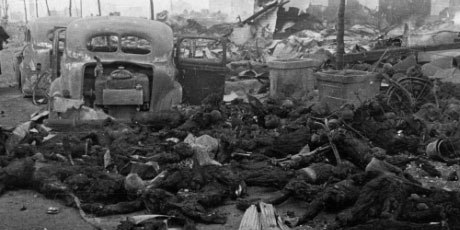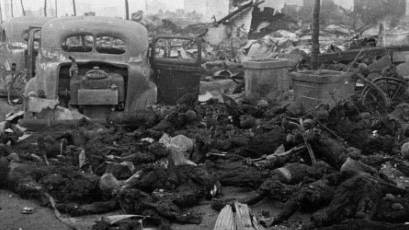What we can learn from the day the US burned to death 100,000 women and children
Source: stopwar.org.uk

America's needless firebombing of Tokyo in 1945 is one of the 'good war' myths used to justify the endless war policies of today.
March 9, 2015 marked the seventieth anniversary of the American firebombing of Tokyo, World War II’s deadliest day.
More people died that night from napalm bombs than in the atomic strikes on Hiroshima and Nagasaki. But few in the United States are aware that the attack even took place.
The lack of ceremonies or official state apologies for the firebombing is unsurprising considering that many Americans see World War II as the “just war” fought by the “greatest generation.” These labels leave the war and the atrocities Americans committed during it largely untouched by critique.
The little that is available to study on the firebombing, at least here in the US, is told from the perspective of American crewmen and brass, through usually biased American military historians. Those seeking better understanding of the March 9 tragedy must wade through reams of history primarily devoted to strategy; the heroics of American soldiers; the awesome power behind the bombs unleashed that day; and a cult-like devotion to the B-29 Superfortress, the plane that dropped the napalm over Tokyo and the atomic bombs, and was the inspiration for George Lucas’s Millennium Falcon.
The overriding narrative surrounding the events of March 9, 1945 is that the American pilots and military strategists such as Gen. Curtis LeMay, the architect of the firebombing, had no other option but to carry out the mission. The Americans had “no choice” but to burn to death nearly one hundred thousand Japanese civilians.
Most historians seem to believe that LeMay should be commended for making “tough choices” in wartime, for it was these tough choices that allegedly saved lives on both sides by ending the war sooner.
What little criticism that exists of the firebombing is attacked for failing to put the bombing in proper context and not providing alternate solutions for ending the war. These attacks are also riddled with “they did it too” justifications.
World War II was carried out with brutality on all fronts. The Japanese military murdered nearly six million Chinese, Korean, and Filipino civilians by the end of it. However, to argue that Japanese civilians deserved to die — that children deserved to die — at the hands of the US military because their government killed civilians in other Asian countries is an indefensible position, in any moral or ethical framework.
Operation Meetinghouse saw more than three hundred B-29 bombers flying at ten thousand (as opposed to their usual thirty thousand feet) to avoid the effects of a 100 to 200 MPH jet stream, and setting Tokyo ablaze in the late hours of March 9. The American planes dropped five hundred thousand M-69 bombs (nicknamed “Tokyo Calling Card”), which were designed specially to consume the largely wooden residential structures of Tokyo.
Clustered in groups of thirty-eight, each M-69 weighed six pounds. The five hundred–pound clusters would disperse at two thousand feet. A white phosphorus fuse that looked like a gym sock ignited flaming jellied gasoline that spurted one hundred feet in the air on impact.
Like a sticky fiery plague, the globs of napalm clung to everything it touched. The M-69s were so effective at starting fires in Tokyo that night that gale force winds turned thousands of individual fires into one massive firestorm. Temperatures around the city raged between 600 and 1800 degrees Fahrenheit. In some areas, the fires melted asphalt.
LeMay planned the attack to coincide with 30 MPH winds in order to intensify the effect of the bombs. Ultimately, sixteen square miles of Tokyo were reduced to ash.
LeMay claimed that the Japanese government relied on residential “cottage” war production, thus making the civilians living in Tokyo a legitimate military target. However, by 1944 the Japanese had essentially terminated its home war production. A full 97 percent of the country’s military supplies were protected underground in facilities not vulnerable to air attack the day of the bombing. The Americans knew this.
The United States had broken Japan’s Red and Purple cipher machines well before 1945, allowing them access to the most classified enemy intelligence. American generals understood the war would soon be materially impossible for the Japanese.
The US Naval blockade had also prevented oil, metal, and other essential goods from entering Japan long before March 9. Japan was so cut off from basic supplies that it was constructing its planes partially out of wood.
The Japanese population at this point in the war was most concerned with starvation. The 1945 rice harvest was the worst since 1909. Surveys commissioned by Japan’s government in April 1945 reported the population was “too preoccupied with the problems of food” to worry about fighting a war. Victory for the Allies was guaranteed by the start of the year.
The most damning evidence against the firebombing can be traced to August 19, 1945, when Walter Trohan of the Chicago Tribune finally published a piece gracefully titled “Roosevelt Ignored M’Arthur Report on Nip Proposals” that he had been sitting on for seven months.
Trohan wrote:
Release of all censorship restrictions in the United States makes it possible to report that the first Japanese peace bid was relayed to the White House seven months ago. . . .
The Jap offer, based on five separate overtures, was relayed to the White House by Gen. MacArthur in a 40-page communication, [who] urged negotiations on the basis of the Jap overtures. . . .
The offer, as relayed by MacArthur, contemplated abject surrender of everything but the person of the Emperor. President Roosevelt dismissed the general’s communication, which was studded with solemn references to the deity, after a casual reading with the remark, “MacArthur is our greatest general and our poorest politician.”
The MacArthur report was not even taken to Yalta.
In January 1945 — two days before Franklin Roosevelt was to meet with British Prime Minister Winston Churchill and Soviet leader Joseph Stalin in Yalta — the Japanese were offering surrender terms almost identical to what was accepted by the Americans on the USS Missouri in the Japan Bay on September 2, 1945.
The Japanese population was famished, the country’s war machine was out of gas, and the government had capitulated. The Americans were unmoved. The firebombing and the nuclear attacks were heartlessly carried out. If anyone is guilty of disregarding the “context” of the firebombing of Tokyo, it’s the sycophantic and biased American historians who deride these critical facts.
[...]
Read the rest: stopwar.org.uk
Story via: nonalignedmedia.com






















